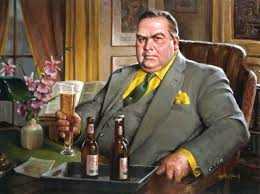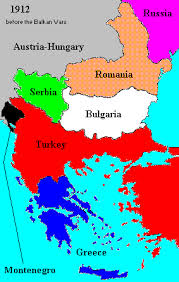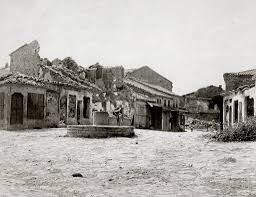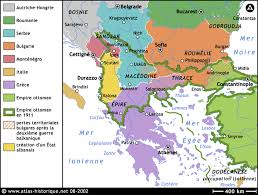One hundred years ago today the
Treaty of London was signed ending the
First Balkan War which, along with the
Second Balkan War, would be the "table setters" for the outbreak of
World War One (ultimately triggered by the assassination of the Archduke Ferdinand of Austria-Hungary and his wife in Sarajevo by Serbian nationalists on June 28, 1914.
The First Balkan War saw Serbia, Bulgaria, Greece and Montenegro (the Black Mountain, birthplace of
Rex Stout's famous fictional detective,
Nero Wolfe) team up to drive the Ottoman Turks out of Europe.

(
Nero Wolfe) Its significance for WWI was that its outcome settled Serbia's southern expansionist claims and allowed it to refocus to the north on its fellow-Slavs ruled by Austria-Hungary.
The Ottomans had first expanded into Europe in 1354 and since the early 15th century had dominated most of the Balkans (Bulgaria, Greece, Albania and the former Yugoslavia), extending their rule at its peak in the 17th century to Hungary, Romania and parts of what are now the southern Ukraine and Russia.
As the Ottoman Empire declined during the course of the 19th century, Romania became independent and three states that had disappeared four centuries before, Serbia, Bulgaria and Greece, were recreated, though geographically smaller than their current versions, and the provinces of Bosnia and Herzegovina were occupied by Austria-Hungary.
By 1912, the Ottoman's rule (also known as Turkey) had been reduced to Albania, Macedonia and Thrace. The map below shows the situation as of that date:

Montenegro, Greece, Bulgaria and Serbia believed the time was ripe to strike since the Ottomans were preoccupied fighting Italy which had invaded Libya (then a part of their empire) and the Dodecanese Islands in the Aegean, which included Rhodes, as well as facing an Albanian revolt.
Although they were united in their desire to beat the Turks their respective nationalist goals were incompatible. The biggest problem was Macedonia - the Bulgars thought the Macedonians were Bulgars, the Serbs thought they were Serbs and the Greeks believed they were Greeks. None of them thought there was any such thing as a Macedonian. Nonetheless, the four Christian nations entered an alliance known as the Balkan League to fight the Turks. A complicating factor was the ongoing revolt of the Albanian Moslems along the Adriatic Coast, who sought independence from the Turks. They were supported by the Serbs although both the Albanians and Serbs claimed the Turkish province of Kosovo (they still do a century later).
The war began with attacks by the Balkan League in October 1912 and by March 1913 the Turks had been thoroughly defeated. The Treaty of London eliminated Turkey from Europe with the exception of Istanbul and a very small hinterland around the city.

(
Destroyed village)

(
Bulgarian infantry)
Bulgaria expanded substantially, gaining extensive territory to the south, a slice of Macedonia and large stretches of coast along the Aegean and Sea of Marmara. Serbia expanded to the south taking Kosovo and another slice of Macedonia. Montenegro gained part of the Sanjak of Novibazar (you can look it up), Albania's independence was recognized and Greece expanded northwards gaining the key port of Salonika which had fallen to the Turks in 1430 as well as a portion of Macedonia. This was what the map looked liked at the end of the war.

But even before the end of the First Balkan War, the groundwork was laid for the next war. Bulgaria made it clear that it was dissatisfied with its share of Macedonia and intended to reach a "fairer" settlement even if force was needed. In response, Greece and Serbia concluded a secret alliance on May 1, 1913
(before the Treaty of London was signed). Russia, a close ally of both Bulgaria and Serbia, interceded to try to mediate a settlement but was frustrated by Bulgarian intransigence and withdrew. Two weeks after the Treaty of London was signed, Bulgarian forces attacked the Greek and Serbian armies in Macedonia and the Second Balkan War began.
Strangely, in making its war plans the Bulgarians did not take into account the possible actions of the Turks and Romanians. The Turks had an obvious interest in regaining some of their recently lost territories and the Romanians had a long standing grievance over a slice of land known as the Dobrudja which lay south of the Danube and adjacent to the Black Sea and which was currently part of Bulgaria.
The war lasted only six weeks and was a disaster for Bulgaria. The Greeks and Serbs won the battles in Macedonia. The Turks launched a successful attack and the Romanians invaded and almost reached Bulgaria's capital, Sofia, before the Bulgarians agreed to a ceasefire. In the resulting settlement, Bulgaria lost its slice of Macedonia, the Dobrudja, part of the territory recently ceded by Turkey and its access to the Aegean was limited to a harborless stretch of coast (and they were to lose even this in the aftermath of WWI). Greece, Serbia, Albania and Montenegro all gained territory.
This map shows both the 1912 status (outlined in green) and the boundaries after the second war:

The festering resentment of Bulgaria against its former Allies led it to join the Central Powers (Germany, Austria-Hungary, Turkey) in the First World War. Initially it seemed like a good decision. In 1915, Bulgarian forces, along with those of Austria-Hungary and Germany, crushed Serbia and it was able to occupy most of Macedonia. They also threatened the Greek port of Salonika and, after Romania foolishly declared war on Austria-Hungary in 1916, attacked and reclaimed the Dobrudja. But it all went wrong in the end.
A Serb-dominated Yugoslavia, including Montenegro, Macedonia, Bosnia, Herzegovina, Croatia and Slovenia, was created after WWI but it shattered during the bloody wars of the 1990s. Macedonia is now an independent country although Greece objects to its use of the name.
 There is always something you've never seen before in baseball and 28-year old Los Angeles Angels pitcher Robert Coello has come up with a pitch last thrown perhaps 90 years ago. It's thrown with a forkball grip (see below) but with no spin so it has knuckleball type action and unpredictability.
There is always something you've never seen before in baseball and 28-year old Los Angeles Angels pitcher Robert Coello has come up with a pitch last thrown perhaps 90 years ago. It's thrown with a forkball grip (see below) but with no spin so it has knuckleball type action and unpredictability..JPG)
.JPG)